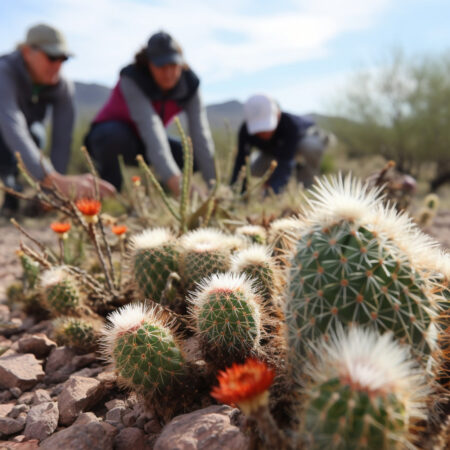Key Takeaways:
- Cacti face threats such as habitat loss, climate change, and illegal collection
- Cacti play a vital role in ecosystems by providing water, pollination, and habitat
- Cacti have economic value through cultural uses and horticultural trade
- Cactus conservation efforts face challenges of limited funding, lack of public awareness, and illegal trade
- Funding opportunities for cactus conservation include government grants, corporate sponsorship, and crowdfunding
- Successful cactus conservation requires propagation techniques, community engagement, and collaboration among organizations
The Importance of Cactus Conservation
Cacti, with their characteristic spines and unique shapes, are not only iconic symbols of arid landscapes but also play a crucial role in maintaining the delicate balance of ecosystems around the world. However, these fascinating plants are facing numerous threats that put their survival at risk. Understanding the importance of cactus conservation is essential to safeguard these remarkable species.
1. The Threats to Cactus Survival
Cacti face a range of threats that jeopardize their survival. One of the most significant challenges is habitat loss due to urbanization, agriculture, and infrastructure development. As human activities continue to expand, cacti are losing their native habitats, leading to a decline in their populations.
Climate change is another major threat to cactus survival. Increasing temperatures and changing rainfall patterns are altering the environments in which cacti thrive, making it difficult for them to adapt and survive. Additionally, extreme weather events such as droughts and storms can have devastating effects on cactus populations.
Illegal collection and trade of cacti is also contributing to their decline. Many cactus species are sought after by collectors and enthusiasts, leading to overharvesting and the depletion of wild populations. Furthermore, habitat destruction has opened up opportunities for illegal trade, making it even more challenging to protect these plants.
2. The Role of Cacti in Ecosystems
Cacti play a vital role in the ecosystems they inhabit. Their unique adaptations allow them to thrive in arid environments where other plants struggle to survive. By efficiently storing water in their thick stems, cacti act as reservoirs during periods of drought, providing a crucial water source for other organisms.
The flowers of cacti are also important for pollinators, such as bees, butterflies, and bats. These animals rely on the nectar and pollen provided by cacti, contributing to the reproduction of both cactus species and other flowering plants in the ecosystem.
Cacti also provide shelter and food for a variety of animals. Their spiny stems offer protection from predators, while their fruits and pads serve as a source of nutrition for birds, reptiles, and mammals. By supporting diverse animal populations, cacti help maintain the overall biodiversity of their ecosystems.
3. The Economic Value of Cactus Species
Cacti have significant economic value, especially in regions where they are native. Many cactus species have cultural and medicinal uses that have been passed down through generations. Indigenous communities rely on cacti for food, construction materials, and traditional medicine.
Furthermore, cacti have become increasingly popular in landscaping and horticulture, contributing to the horticultural trade industry. Rare and unique cactus species are highly sought after by collectors and can fetch high prices in the market.
The economic value of cacti provides an additional incentive for their conservation, as preserving these species can contribute to sustainable livelihoods and economic development in local communities.
Challenges in Cactus Conservation Efforts
The conservation of cacti faces several challenges that hinder effective preservation and protection of these plants. Addressing these challenges is essential to ensure the long-term survival of cacti species.
1. Limited Funding
One of the significant obstacles in cactus conservation efforts is the lack of funding. Cacti often receive less attention and funding compared to other charismatic species, making it challenging to implement comprehensive conservation programs.
To address this issue, it is crucial to raise awareness about the importance of cactus conservation and secure additional funding from governmental organizations, non-profit foundations, and international donors. Investing in cactus conservation will not only protect these unique plants but also contribute to the overall health of ecosystems they inhabit.
2. Lack of Public Awareness and Support
The general public often has limited knowledge about cacti and their ecological importance. Without awareness and support from the public, conservation efforts can struggle to gain momentum and effectiveness.
Educational programs and campaigns focused on raising awareness about the value of cacti and the threats they face are essential. Engaging the public through media, community events, and educational materials can help generate support for cactus conservation and encourage individuals to take action.
3. Illegal Cactus Trade and Harvesting
The illegal trade and harvesting of cacti pose a significant threat to their survival. The demand for rare and unique species in the horticultural and collectors’ markets drives the illegal trade, leading to the unsustainable exploitation of wild populations.
To combat illegal cactus trade, stricter enforcement of existing laws and regulations is necessary. Collaborative efforts between governments, law enforcement agencies, and conservation organizations can help disrupt illegal supply chains and protect cacti from overexploitation.

Funding Opportunities for Cactus Conservation
While funding for cactus conservation may be limited, various opportunities exist to support and finance conservation efforts.
1. Government Grants and Funding Programs
Governmental organizations and agencies often provide grants and funding programs specifically designed for conservation purposes. These grants can support research, habitat restoration, community engagement, and other essential aspects of cactus conservation.
Conservationists and organizations dedicated to cactus preservation should actively explore and apply for these funding opportunities to secure the necessary resources for their initiatives.
2. Corporate Sponsorship and Partnerships
Engaging with corporations that have a vested interest in environmental conservation can provide significant financial support for cactus conservation efforts. By forming partnerships with businesses, conservation organizations can access funding, expertise, and resources that can enhance their effectiveness.
Corporate sponsorship and partnerships not only provide financial support but also raise awareness about cactus conservation among a broader audience through marketing and outreach activities.
3. Crowdfunding Initiatives for Cactus Conservation
Crowdfunding has emerged as a popular and successful means of raising funds for various causes. Launching crowdfunding campaigns specifically targeted towards cactus conservation can help generate financial support from individuals who are passionate about preserving these unique plants.
Organizations and individuals involved in cactus conservation can leverage social media platforms and online fundraising platforms to reach a wide audience and encourage donations.
Resources and Strategies for Successful Cactus Conservation
The successful conservation of cacti requires a combination of resources and strategies to address the unique challenges these plants face.
1. Cactus Propagation and Restoration Techniques
Propagation and restoration techniques are essential tools in cactus conservation. By propagating cacti through various methods such as seeds, cuttings, and tissue culture, conservationists can increase their numbers and reintroduce them into restored habitats.
Collaboration between botanical gardens, nurseries, and conservation organizations can help develop effective propagation techniques and ensure a sustainable supply of propagated cacti for restoration purposes.
2. Community Engagement and Education Programs
Engaging local communities in cactus conservation efforts is crucial for long-term success. Community education programs can raise awareness about the importance of cacti and provide training on sustainable harvesting practices, promoting the conservation of wild populations.
Additionally, involving local communities in habitat restoration projects and providing alternative livelihood opportunities can create a sense of ownership and foster a conservation mindset among the local population.
3. Collaboration and Networking among Conservation Organizations
Collaboration and networking among conservation organizations are essential for sharing knowledge, resources, and expertise. By working together, organizations can maximize their impact, coordinate conservation efforts across regions, and develop holistic strategies for cactus preservation.
International partnerships and collaborations can also facilitate the exchange of information and best practices, contributing to a more effective and coordinated approach to cactus conservation on a global scale.
By understanding the importance of cactus conservation, addressing the challenges at hand, exploring funding opportunities, and implementing effective conservation strategies, we can nurture and protect these unique plants for generations to come.
FAQ
Question: What are the threats to cactus survival?
Answer: Cacti face threats such as habitat loss, climate change, and illegal collection. These factors contribute to the decline in cactus populations.
Question: How do cacti contribute to ecosystems?
Answer: Cacti play a vital role in ecosystems by providing water, pollination, and habitat. Their ability to efficiently store water in their stems makes them reservoirs during droughts. Their flowers attract pollinators, and their spiny stems offer shelter and food for various animals.
Question: What is the economic value of cactus species?
Answer: Cacti have economic value through cultural uses and horticultural trade. Indigenous communities rely on cacti for food, construction materials, and traditional medicine. In the horticultural trade industry, rare and unique cactus species can fetch high prices in the market.
Question: Why is funding limited for cactus conservation?
Answer: Funding for cactus conservation is limited because cacti often receive less attention and funding compared to other charismatic species. This makes it challenging to implement comprehensive conservation programs.
Question: How can public awareness and support be increased for cactus conservation?
Answer: Public awareness and support for cactus conservation can be increased through educational programs and campaigns. Media, community events, and educational materials can be utilized to raise awareness about the value of cacti and the threats they face.
Question: What are the challenges posed by illegal cactus trade and harvesting?
Answer: Illegal cactus trade and harvesting contribute to the decline in cactus populations. The demand for rare and unique species in the horticultural and collectors’ markets drives the illegal trade, making it unsustainable.
Question: What are some funding opportunities for cactus conservation?
Answer: Funding opportunities for cactus conservation include government grants and funding programs specifically designed for conservation purposes. Corporate sponsorship and partnerships with businesses interested in environmental conservation can also provide financial support. Crowdfunding campaigns targeted towards cactus conservation can generate financial support from individuals passionate about preserving these plants.
Question: What resources and strategies are necessary for successful cactus conservation?
Answer: Successful cactus conservation requires resources such as propagation and restoration techniques, community engagement and education programs, and collaboration and networking among conservation organizations. These strategies help increase cactus numbers, raise awareness, and coordinate conservation efforts.
Founder of CactusClassification.science, David has dedicated years to studying and documenting the diverse world of cacti. Hailing from Arizona, his passion is rooted in the desert landscapes of his childhood. Through this website, David offers insights into cactus taxonomy and care, bridging the gap between scientific research and everyday enthusiasts.



Comments